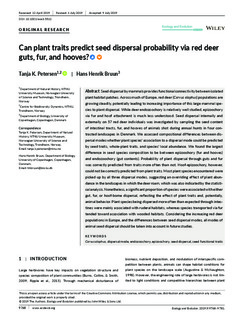| dc.contributor.author | Petersen, Tanja Kofod | |
| dc.contributor.author | Bruun, Hans Henrik | |
| dc.date.accessioned | 2020-02-10T12:12:52Z | |
| dc.date.available | 2020-02-10T12:12:52Z | |
| dc.date.created | 2019-09-16T15:28:01Z | |
| dc.date.issued | 2019 | |
| dc.identifier.citation | Ecology and Evolution. 2019, 9 (17), 9768-9781. | nb_NO |
| dc.identifier.issn | 2045-7758 | |
| dc.identifier.uri | http://hdl.handle.net/11250/2640702 | |
| dc.description.abstract | Seed dispersal by mammals provides functional connectivity between isolated plant habitat patches. Across much of Europe, red deer (Cervus elaphus) populations are growing steadily, potentially leading to increasing importance of this large mammal species to plant dispersal. While deer endozoochory is relatively well studied, epizoochory via fur and hoof attachment is much less understood. Seed dispersal internally and externally on 57 red deer individuals was investigated by sampling the seed content of intestinal tracts, fur, and hooves of animals shot during annual hunts in four contrasted landscapes in Denmark. We assessed compositional differences between dispersal modes whether plant species' association to a dispersal mode could be predicted by seed traits, whole‐plant traits, and species' local abundance. We found the largest difference in seed species composition to be between epizoochory (fur and hooves) and endozoochory (gut contents). Probability of plant dispersal through guts and fur was correctly predicted from traits more often than not. Hoof‐epizoochory, however, could not be correctly predicted from plant traits. Most plant species encountered were picked up by all three dispersal modes, suggesting an overriding effect of plant abundance in the landscapes in which the deer roam, which was also indicated by the statistical analysis. Nonetheless, a significant proportion of species were associated with either gut, fur, or hoof‐borne dispersal, reflecting the effect of plant traits and, potentially, animal behavior. Plant species being dispersed more often than expected through intestines were mainly associated with ruderal habitats, whereas species transported via fur tended toward association with wooded habitats. Considering the increasing red deer populations in Europe, and the differences between seed dispersal modes, all modes of animal seed dispersal should be taken into account in future studies. | nb_NO |
| dc.language.iso | eng | nb_NO |
| dc.publisher | John Wiley & Sons | nb_NO |
| dc.relation.uri | https://doi.org/10.6084/m9.figshare.7982483 | |
| dc.rights | Navngivelse 4.0 Internasjonal | * |
| dc.rights.uri | http://creativecommons.org/licenses/by/4.0/deed.no | * |
| dc.title | Can plant traits predict seed dispersal probability via red deer guts, fur, and hooves? | nb_NO |
| dc.type | Journal article | nb_NO |
| dc.type | Peer reviewed | nb_NO |
| dc.description.version | publishedVersion | nb_NO |
| dc.source.pagenumber | 9768-9781 | nb_NO |
| dc.source.volume | 9 | nb_NO |
| dc.source.journal | Ecology and Evolution | nb_NO |
| dc.source.issue | 17 | nb_NO |
| dc.identifier.doi | 10.1002/ece3.5512 | |
| dc.identifier.cristin | 1725254 | |
| dc.description.localcode | This is an open access article under the terms of the Creative Commons Attribution License, which permits use, distribution and reproduction in any medium, provided the original work is properly cited. | nb_NO |
| cristin.unitcode | 194,31,10,0 | |
| cristin.unitname | Institutt for naturhistorie | |
| cristin.ispublished | true | |
| cristin.fulltext | original | |
| cristin.qualitycode | 1 | |

